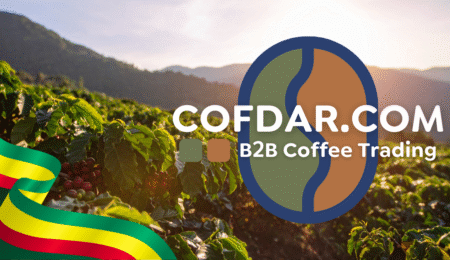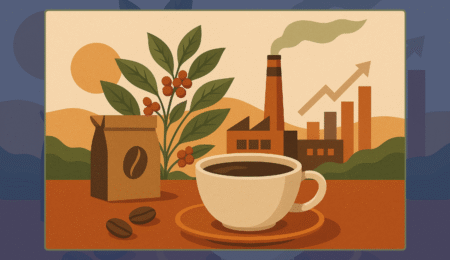The global coffee markets in August 2025 experienced unprecedented volatility and tension. Prices surged to record levels while exports from major producers declined. The monthly report issued by the International Coffee Organization (ICO) paints a complex picture shaped by climatic pressures, political and trade challenges, and shifts in global consumption patterns. This analytical report reviews the key figures, explores their causes, and highlights potential scenarios for the future of this strategic commodity.
I. Price Developments – Broad-Based Surge Across All Categories
The ICO Composite Indicator Price (I-CIP) averaged 297.05 US cents/lb in August 2025, up 14.6% from July and 24.3% from August 2024. This represents one of the highest levels in more than a decade.
- Prices ranged between 249.12 and 344.64 US cents/lb.
- The 12-month moving average stood at 301.13 US cents/lb, reflecting relative stability at elevated levels.
Breakdown of Main Groups
- Colombian Milds: 366.72 US cents/lb (+13.8%).
- Other Milds: 366.32 US cents/lb (+12.5%).
- Brazilian Naturals: 366.88 US cents/lb (+13.4%).
- Robustas: 199.13 US cents/lb (+19.1%), the fastest growth rate among all categories.
This broad-based increase shows that all segments of the market were under pressure, with Robustas standing out as a substitute option for buyers.
II. Main Drivers Behind Price Increases
1. U.S. Tariffs on Brazilian Coffee
The U.S. decision to impose 50% tariffs on Brazilian coffee reshaped the market dynamics. As Brazil is the world’s largest exporter, importers were forced to seek more expensive alternatives, pushing global prices higher.
2. Slow Marketing in Brazil
Although over 99% of the 2025/26 crop has been harvested, only about 35% has been marketed. This reduced the available supply in global markets, widening the gap between demand and supply.
3. Decline in Bean Quality
Market reports indicated that some Brazilian beans, despite large screen sizes, showed reduced density. This affected total crop estimates and added further upward pressure on prices.
4. European EUDR Legislation
The EU is preparing to implement the Deforestation Regulation (EUDR) at the end of December 2025. To avoid compliance risks, many European roasters stockpiled beans in advance, boosting short-term demand.
5. Frost in Brazil
A mild frost in mid-August is estimated to have damaged up to half a million bags. Although limited in scale, even the potential threat of shortages contributed to higher prices.
6. Activity of Roasters and Hedge Funds
The U.S. CFTC Commitment of Traders report revealed a sharp increase in long positions by the commercial category (roasters). This hedging strategy amplified demand in futures markets and drove up physical prices.
III. Market Volatility and Stocks
- Daily volatility rose to 11% (+0.8 points).
- Certified Robusta stocks in London fell to 1.13 million bags (-4.6%).
- Certified Arabica stocks dropped to 0.77 million bags (-7.9%), the lowest since April 2024.
Falling certified stocks underline the fragile balance between supply and demand, meaning any additional shocks could push prices even higher.
IV. Global Exports – Decline Despite High Prices
Green Coffee Exports
Global exports in July 2025 totaled 10.3 million bags (-0.7% year-on-year).
- Brazil: 2.69 million bags (-16.8%).
- Colombia: 1.17 million bags (+9.6%).
- Other Milds: 2.52 million bags (+7.3%).
- Robustas: 3.92 million bags (+5.2%).
Exports of All Forms of Coffee
Total exports across all forms reached 11.42 million bags (-1.6%).
- South America: down 18.5% to 4.4 million bags.
- Central America & Mexico: up 7.2% to 1.63 million bags.
- Asia & Oceania: up 22.7% to 3.34 million bags, mainly from Vietnam.
- Africa: up 4.4% to 2.05 million bags.
Market Share Shifts
The share of Arabicas rose to 62.7% from 61.6% a year earlier, confirming strong demand for premium coffee despite higher prices.
V. Historical Context
- The 2023/24 coffee year saw record exports of 125.44 million bags (+12.4%).
- The average annual net increase between 2011/12 and 2018/19 was only 3.32 million bags, making 2023/24 exceptional.
- The current downturn (2024/25) is both a correction and a sign of structural changes, including the growth of soluble coffee production in India and Vietnam.
VI. Structural Shifts in the Market
There is a gradual move away from raw green coffee exports toward value-added products such as soluble coffee.
- India expanded capacity by about 0.89 million bags between 2020 and 2025.
- Vietnam added nearly 1.92 million bags.
- Nestlé’s plant in Mexico began operations in 2022 with a capacity of 0.67 million bags.
This reflects producing countries’ ambitions to reduce dependence on volatile green coffee prices.
VII. Outlook
Short Term (6 Months)
- Prices likely to remain high due to supply shortages.
- Robustas will continue to act as substitutes for Arabicas, particularly as price spreads widen.
Medium Term (1–3 Years)
- Implementation of the EUDR will reshape trade flows. Producers that can prove sustainability will gain greater market access.
- Competition between Brazil and Vietnam for Robusta dominance will intensify.
Long Term (5+ Years)
- Climate change remains the biggest threat, with rising risks of frost and drought.
- A continued shift toward locally processed coffee products is expected, reducing the relative share of green coffee in world trade.
The August 2025 report confirms that the global coffee market stands at a crossroads:
- On one hand, high prices are supporting producers in the short run.
- On the other, falling exports, climatic risks, and new regulations make the future uncertain.
With ongoing U.S. tariffs and the looming EUDR enforcement, the coming years will witness a reshaping of global coffee trade flows. Producers and importers alike will need more flexible strategies to navigate this complex environment.





Leave a Reply